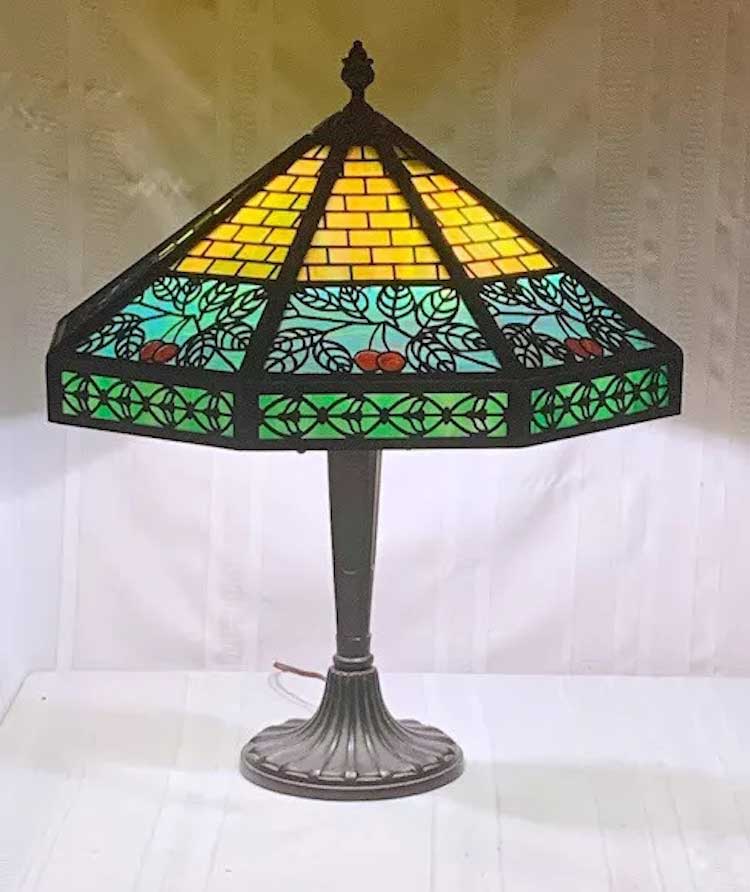September 2024
Good Eye
The Heyday of Glass Lampshades
by Peggy Whiteneck
Most of the lampshades made before the late 19th century were glass globes for oil lamps. Sometimes these would be produced in colored glass for both the lamp base and the shade. But most shades were narrow lantern-style and made of clear glass.
The first electric light bulbs were invented in the last two decades of the 19th century; Thomas Edison’s Edison Electric Life Co. didn’t develop a commercially available bulb until 1880. By 1885, 300,000 electric lamps were estimated to have been sold in the USA although they didn’t become widely used until the first decade or so of the 20th century (www.historyoflamps.com/lamp-history/history-of-electric-lamps).
The earliest lampshades were made of metal or glass. In the late Victorian era, they became more elaborate and decorative, using cloth materials, beads, lace, and fringe (www.premierlampshades.co.uk/blog/history-of-lampshades).
Today’s commercially available glass lampshades are so basic in design and color (usually white) that they’re made to be purely functional as lighting. Older glass shades strove for a more aesthetic appeal. Perhaps the most famous early examples were produced by Louis Comfort Tiffany’s company.
Tiffany’s stained-glass effects were so colorful that they were spectacular when lit from within. The earliest examples were made in 1895 and the latest in the 1920s, making them all antiques today.
Tiffany-style lamps have been made by other manufacturers that could produce them cheaply enough that more than the upper class of society could afford the Tiffany lamp look. Original, genuine Tiffany lamps are considered the ultimate prize in old electric lamps and are priced on the secondary market accordingly, from three figures to over $1,000,000 in some cases! Authentic Tiffany lamps will have TIFFANY STUDIOS NEW YORK in capital letters stamped into the metal rim of the shade or on the glass shade itself. The use of lowercase letters would mean the lamp is not authentic Tiffany. For more information on telling real Tiffany lamps from fakes, check out Kovel’s Antique Trader article on the topic (https://www.antiquetrader.com/antiques/tiffany-lamps-how-to-tell-real-from-fake).
Of course, Tiffany wasn’t the only producer of electric lamps. Among other interesting effects were reverse-painted glass lampshades, painted on the inside of the shade rather than outside (Think about what it would have been like to try to paint the rounded inside of a shade even before the shade was installed on a lamp!).
Reverse-painted lamps were made by several companies in the early 1900s such as Pittsburgh Lamp Co., Handel, and Phoenix Glass (www.southcoasttoday.com/story/news/2002/03/10/shedding-light-on-reverse-painted/50366817007).
Although lighting was not its only product, the Bradley & Hubbard Manufacturing Co. also made lamps with colorful glass shades. These were not as elaborate in color or style as those made by Tiffany, but they were works of art in their own terms. B & H lamps are characterized by fancy metal frames holding the glass in the shade. Bradley & Hubbard lamps can be found in both electrified and oil lamp form and may have a telescoping base, a feature invented by that company.

This Bradley & Hubbard lampshade is currently offered on eBay, not yet sold but with 18 “watchers” and asking $1,995. (Image courtesy of eBay)
In the 20th century, Fenton electric lamps also used glass shades made both in colored glass and in hand-painted forms. These remain very popular on the secondary market and routinely sell from the low hundreds of dollars and upward. These range in style from the ”Gone with the Wind” type, with large glass globes on both the base and the shade, to simpler forms with a metal base just the shade in glass. Pairing the latter with their original metal bases can be a challenge, but most collectors are buying these for the glass shade and focus less on whether the metal frame is original.
Here’s a caution, though, for buyers of older electric lamps. Many lamps with glass shades were produced late enough that they have standard electric plugs, but some of the oldest, such as some made by companies mentioned above, may need to be rewired with plugs able to be used in modern sockets.
Peggy Whiteneck is a writer, collector, and dealer living in East Randolph, VT. If you would like to suggest a subject that she can address in her column, email her at allwritealready2000@gmail.com.

